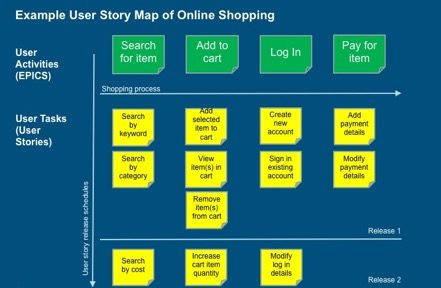by Business Analysis (BAPL)
User Stories and User Story Mapping are must have techniques of a business analyst. You can do business analysis without Scrum, but you can’t do good Scrum without Business Analysis. Story mapping enables clarity of user stories.
Story Mapping
“Story mapping is the process of arranging user stories into a useful model to help understand the functionality of the system” http://jpattonassociates.com/the-new-backlog/. This technique allows for the planning and prioritising of requirements in order of importance and value. Story mapping orders user stories along two independent dimensions. The horizontal axis depicting the user activities in order of priority or the sequence of process activities and the vertical axis depicting the release or project milestones https://www.agilealliance.org/glossary/storymap/.

Once used, story mapping can enable the project team to dice stories (often at Epic level) horizontally into the main functionality. This horizontal view is important as it visually represents the value stream of the designed solution. This analysis allows the project team to understand the dependencies and highlights gaps for how the created user story functionality will work. This end to end perspective can be enhanced by understanding the customer journey of a person using the solution.
Having knowledge of the process enables the identification of stakeholders to be brought into the picture. The additional identified stakeholders help validate whether user stories are accurate and allows the project team to introduce change management activities early. One change management strategy which user story mapping encourages is to facilitate stakeholder buy in. This is vital and benefits the project team as these stakeholders can help develop additional user stories that the project team potentially have missed, elicit business impacts and helps validate design and prioritisation discussions.
The vertical axis is important as it represents the project teams user story release plans. Project team discussions will be centred on which user stories are high value and easy to develop. Complex user stories could be left to later releases with the focus of the project team having to create a minimum viable product for the customer. Sprint reviews can help fine tune the product and allow the project team to regularly assess user story release patterns. The vertical positioning of user stories enables the project team to discuss whether user stories can be prioritised in terms of need, value and complexity.
User stories capture requirements and the use of User Story Mapping, although simple, can be used to model a meaningful sequence of user activities, perpendicularly across a prioritised ranking of user stories. The benefit of which encourages richer discussion in planning and prioritising user stories, further engages stakeholder participation, is a mechanism to help understand business impacts and can allow a team to visually see how user stories affect the customer journey.
